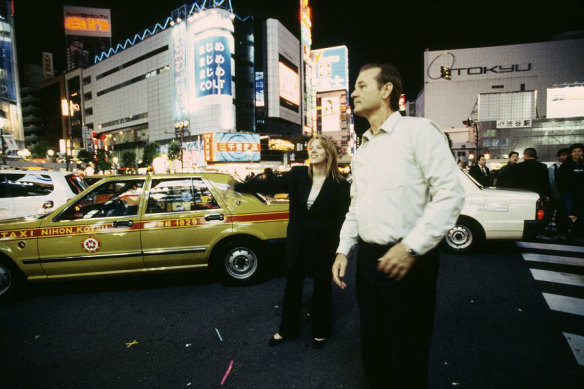This was published 2 years ago
Opinion
Rewatching Lost in Translation nearly 20 years on: a rude awakening
Amelia Lester
ColumnistThey say you can’t go home again. I would also caution against revisiting cult classics from 20 years prior, unless you’d like a rude awakening as to how clueless we all were back then.

Scarlett Johansson and Bill Murray in Lost In Translation: nearly 20 years on, the ‘romance’ element in the Oscar-winning screenplay hits a different note.
The movie which prompted this thought was Lost in Translation, the Tokyo travelogue that was greeted rapturously in 2003, and which I thought might be fun to watch one evening recently while missing Japan.
Sofia Coppola may have won an Oscar for best screenplay, but the “romance” element of her plot hits differently these days. At the time of shooting, Scarlett Johansson was 17. Bill Murray, her co-star and love interest, was in his early 50s. For most of the movie, the connection between Johansson’s Charlotte and Murray’s Bob is sweetly platonic, but at the end, the duo says goodbye to each other with a lingering lip lock.
One bright spot is that many of the scenes are set in the Tokyo Park Hyatt, which I can attest from my own travels still looks fresh and elegant two decades on. The pool, which steals the show from ScarJo and Bill on more than one occasion, might be the most beautiful in the world: sparkling clean on the 47th floor, looking out on Mount Fuji’s radical symmetry.
But much as I love the Park Hyatt, I miss the streets of the city more. It was striking how absent Tokyo was from a movie celebrated, at the time, for capturing its essence. For one, neither main character seems especially interested in exploring: Charlotte is merely a plus-one on her husband’s work trip, slouching moody and pantless in the hotel’s picture windows, while Bob is a washed-up film star who shuttles each day to a nearby studio where he begrudgingly makes a whisky commercial.
A lot of the movie’s humour comes at the expense of locals.
A lot of the humour comes at the expense of locals, who naturally speak a language our protagonists can’t, and won’t, understand. Learning the Japanese for “please” is really not hard, but apparently eludes Bob and Charlotte. A particularly cringeworthy episode involves Murray’s character hectoring a sushi chef – busy preparing an omakase for him – in rapid-fire, ribald English.
Finally, cultural revelation comes in the strangest ways. For Charlotte, it’s singing a karaoke Pretenders song high above the neon lights of Shibuya. For Bob, who has all but rolled his eyes at people trying to do their jobs in a language foreign to him, the most meaningful interactions are the ones he has with a 17-year-old compatriot. This is a shame, given he is visiting one of the world’s most fascinating cities for the very first time.
Different times, different mores. I get it. And maybe a more charitable interpretation is that Lost In Translation is interesting to modern viewers because it depicts how difficult travel was before the ubiquity of mobile phones.
Tokyo, which by design was intended to confuse invaders, is hard to get to know even with Google Maps in your pocket and a thousand travel guides on demand. Without those to assist, the city might appear to be nothing but an awful lot of skyscrapers and dead ends.
My best advice for planning an itinerary in the Japanese capital is to do just that: plan. It is not a place which rewards spontaneity, but rather diligent and meticulous exploration. I hope one day Charlotte and Bob return to Tokyo with smartphones, to make the most of it. And I hope they do it separately.
To read more from Good Weekend magazine, visit our page at The Sydney Morning Herald, The Age and Brisbane Times.